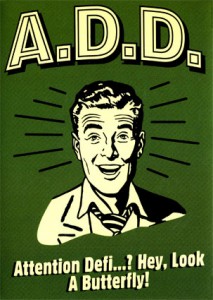10 attention-getters applied to webinars
The science of studying multitasking is young, and as researcher Eyal Ophir points out, it’s a zero-sum game of task switching.
 Presenters in webinars, webcasts, and virtual classrooms often don’t care about the science – they “get” that it’s a challenge to them landing their message (perhaps because we expect that others do what we do when watching a web-based presentation?).
Presenters in webinars, webcasts, and virtual classrooms often don’t care about the science – they “get” that it’s a challenge to them landing their message (perhaps because we expect that others do what we do when watching a web-based presentation?).
Knowing that this is a problem for at least some portion of our audience, let’s look at the nine factors of attention outlined in Principles and Types of Public Speaking, a college textbook I discovered long after I was out of college.
Activity
As psychology professor Daniel Willingham put it simply, “Change gets attention.”
Whether you use animation, use a pointer or drawing tool, or change slides more quickly, one thing is for sure… attendees are still a click away from email and you need to be hyper cognizant as you design and deliver.
Reality
We all have an interest in concrete reality. Avoid the abstruse and abstract thoughts in favor of pragmatic, use-it-now content.
Proximity
As Tip O’Neill once quipped, “All politics is local.” In a webinar there may not be a local connection in terms of locale, but that doesn’t mean you can’t “bring it home” with reference to something that is pertinent to attendees such as their department, their industry, or their common challenges.
Familiarity
In the face of new or strange ideas, references to the familiar create and sustain attention. Use analogies or metaphors to help attendees embrace what is new by illuminating the ideas with the familiar.
One example that I’ve found useful is when teaching virtual classroom or meeting attendees about the context for appropriate usage of private chat. In an in-person environment the experience includes “leaning over to whisper to the person sitting next to you” (not all of which is snarky commentary :)). Private chat in a virtual classroom may serve the same function (“What page of the workbook did he just refer to?”)
Novelty
In contrast with familiarity, something new gets attention – especially when it has a familiar ring to it. As one adage goes, “When a dog bites a man, it’s an accident; when a man bites a dog, it’s news.”
Suspense
Structuring content so it builds to a climax or point of release is a common storytelling tactic. In a webinar, take advantage of the visual nature of the medium to complement this.
One example I use to make this point is to say, “One of the biggest challenges virtual presenters have is that they imagine…” …at which point I shut up and switch the slide to an image of a massively multitasking individual.
Conflict
Controversy compels attention. Don’t underestimate the power of visuals to help your audience more quickly and poignantly not only see, but experience the conflict.
Humor
“What about humor in a webinar or webcast?” is a frequently asked question. People certainly do pay attention more effectively when they’re enjoying themselves (though humor isn’t the only way to accomplish this).
Remember that humor is highly contextual, and a webinar increases the likelihood that you’re reaching a diverse audience. Be relevant, appropriate, and QUICK. This isn’t the time for a drawn out story.
The Vital
People nearly always pay attention to that which affects their own well-being. A well-worn saw is that we all listen to the same radio station…WII FM… “what’s in it for me?”
In a webinar, let ’em know early and often. Use “call backs” to reference the vital such as, “Remember how Julie mentioned the challenge she’s having? This is how this applies when each of you have that challenge.”
Visualization
Visualization is a function of word choice and, if you put your designer hat on, your slides. “A picture is worth a thousand words” is dang near a cliche’, but it’s also true.
Ideally visuals have three qualities: they’re UNDERSTANDABLE, they’re MEMORABLE, and they’re PERSUASIVE.

Zu: Webinar » Online-Lernen + Arbeiten
[…] Virtual Presenter nennt 10 Faktoren, die für die notwendige Aufmerksamkeit der Teilnehmer an einem Webinar sorgen können. Neben der […]
Webinar Howto - webinar
[…] subscribes to a webinar to watch a lengthy comercial. Mainly people surf the web for information. Attendees of a webinar are looking for inspiration, some want to take part in a discussion and ask questions. And everyone […]